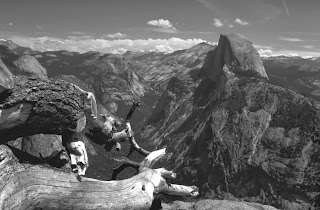This photography was created by a German Photographer named Florian Imgrund, a man who developed his first film camera in 2010. In his photography he plays on human nature by creating double exposures.
The photo above shows a pair of hands in a 'gripping' position' against an image of the forest. You can see the composition has been well thought of and makes the photographs more effective. Florian Imgrund has said that the shot was an 'anologue double exposure'. This means that the effect was simply created with the camera, rather than editing it digitally using photoshop. The use of black and white images adds to the effectiveness of the image, making it look highly captivating due to the dramatic gripping position of the hands with the the tall long trees, creating the impression that every aspect in this is 'reaching out'. This theme creates a connection between the hands and trees which I believe is that the person that these hands belong to needs the trees to live, as the trees are what provide oxygen for us to breathe. The position the hands are in gives a clear meaning, portraying the fact that the person 'needs' the oxygen rather than 'wants' it. Therefore I believe that the photographer (Imgrund) has cleverly composed the hands with the photo of the trees creating a double exposure. Double exposure is a technique that uses a piece of film which is exposed twice to two different images. The result shows the second image placed on top of the other.
After observing this photo and understanding the technique used to create this photo, I have been inspired by Florian Imgrund to create my own double exposure. This is because I am following the pathway of 'landscape photography' for my A2 project. I will use this technique to try and combine two themes together to go beyond the landscape theme. An example of what I could do is photographing portraits of people to place ontop of a landscape photo to create the theme of 'making the world your own' or 'human nature'.
This photo was taken by and 'edited' by an artist named Stephen J Shanabrook. He was born in Cleveland, USA. He is an American conceptual artist who lives and works in New York City as well as Moscow and Russia, and has graduated from a university in Usa called Syracuse University, The Skowhegan School of Art.
In 1995, Stephen Shanabrook begun his career by making different kinds of chocolate pralinés after being inspired by his fathers career, as he (Stephen) had to work in the family buisness' chocolate factory as a child, in a town in Ohio. Using this influence, he begun making chocolate sculptures surrounding and combining the themes: pain, death and disaster. Using this technique, as well as with the photo above of the crushed up portrait (known as photo surgery), his experiments give objects/pictures a new meaning.
The photo above is a part of the collection of photos from the project Stephen did with another artist named Veronika Georgiva; 'Photo Surgery Project', which was selected for a Comme des Garçons ad campaign.
I think that Shanabrook particularly used a female model in this photo to emphasise the fact that we are able to change the appearance of our face, which is something people believe is a way of ruining your face. Shanabrook has conveyed this idea using a handmade technique.
This photo was taken and edited by
a photographer named Amy Friend. She grew up on the outskirts of Windsor,
Ontario, Canada and has previously studied at the Ontario College of Art &
Design, which was after she travelled around Europe, Morocco, Cuba and the USA.
After she went travelling, Amy returned to her studies and gained a BFA Honours
degree, as well as a BEd degree from a university in York. She also managed to
achieve an MFA from the University of Windsor, and a Social Sciences &
Humanities Grant.
Amy has had her work featured in a
range of publications such as: the Magenta Flash Forward Emerging Photography
Competition, EnRoute Magazine, LENS Magazine in China, and lastly The Walrus
Magazine. Amy Friend has also had her work exhibited nationally and
internationally.
In the photo above Amy Friend has
almost made an image look 'magical' by adding her own perception of the view
using a handmade experiment technique. This technique is to simply make holes
in the photo with a pin, and then shine a light towards the back of the photo.
The 'spots of light' almost look like fire flies which is another part of
nature, and relates to the naturalistic landscape in the photo. This has
inspired me to use this technique in my work this year as I am focusing on
landscape photography. I also believe that because she has used such a simple
technique to alter a photo, it allows everyone to have their own
thoughts/perception of what she was trying to portray, rather than having such
an obvious subject matter.
I think that Amy Friend has
carefully thought about composition within this photo. This is because she has
created the main focus of the landscape (using a particular camera angle which
is 'portrait'), the boat with the two people in it. I think that the use of
this was to focus our attention on this aspect to give the impression of
movement and motion. She has cleverly highlighted this idea by adding light
spots around the picture in particular areas such as the boat and the sea. The
use of light it conveys a calm mood, which connects to the theme of the picture
that I have identified; the movement of the rippling sea, allowing us to
possibly feel the emotion that Amy Friend was feeling at the time this picture
was taken. This creates a link/connection between the viewers and the artist
herself.








